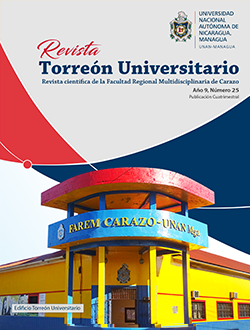Human hair to assess exposure to arsenic in users of contaminated water from La Fuente community in La Paz Centro, León.
DOI:
https://doi.org/10.5377/torreon.v9i25.9856Keywords:
hydroarsenicism, biomarker, bioaccumulation, thermalism, Momotombo volcanoAbstract
The presence of Arsenic in the surface and groundwater of Nicaragua is related to the geoenvironments present in the country. The study area is located NE of the Momotombo volcano, located in the volcanic arc in front of the Nicaraguan Depression, where the predominant geological material is rocks and sediments of the alluvial and volcanic Quaternary. The community of La Fuente is made up of 112 families (1300 inhabitants) that are mostly supplied with water by artisanal sources (90 dug wells and three drilled wells, one of them is communal). In a previous study, total arsenic in water was determined in a range of 2.0 to 103.0 µg/L, with the highest value being reported in a thermal spring; where 70% of the sites monitored (24 wells) reports values not suitable for human consumption (greater than or equal to 10 µg/L). The arsenic present in the water is absorbed by the tissues to be subsequently eliminated in the urine; but when the intake is greater than excretion it tends to be accumulated in hair and nails, as in urine and blood; these are excellent biomarkers to determine acute and chronic exposure to this metalloid. Considering the time of ingestion of water contaminated with arsenic by residents of La Fuente, it was decided to determine whether there is arsenic in the residents of La Fuente, using human hair as a biological indicator. A focus group was identified for this study considering the highest concentrations of arsenic present in water, as well as the longest intake time, resulting in a population group of 43 women and 9 men. Approximately 5 grams of hair was collected from each individual to be evaluated, totaling 52 hair samples. Arsenic concentrations detected in hair ranged from 0.014 to 0.925 µg·g-1; being these values less than 1.00 µg·g-1, standard established as a toxicity criterion by the Quebec Toxicological Center (CTQ). The highest concentrations of arsenic are associated with the oldest person (woman 90 years old) probably due to the longer exposure time; and the youngest (child 7 years), probably because this pollutant is transmitted from mother to children through the umbilical cord, the newborn presenting a concentration similar to her mother at birth. The community members were informed of their results as part of the social commitment to the population subject to the study.
Downloads
Downloads
Published
How to Cite
Issue
Section
License
Los autores que publican en esta revista están de acuerdo con los siguientes términos.
- El autor o los autores de los artículos, ensayos o investigaciones conceden a la Universidad Nacional Autónoma de Nicaragua, Managua (UNAN-Managua) los derechos de edición (copyright) del trabajo enviado, por consiguiente la Universidad cuenta con el derecho exclusivo para publicar el artículo durante el periodo completo de los derechos de autor.
- Estos derechos de autor/ autores autorizan a la Revista Torreón Universitario y a la Universidad editar y divulgar/publicar el artículo en dicha Revista, incluyendo reproducción impresa y electrónica, el almacenamiento, recuperación y cualquier otro tipo de publicación, y fuentes de información secundaria como servicios de resúmenes y bases de datos, así mismo la facultan a proteger el artículo contra el uso no autorizado para su difusión por medios impresos o electrónicos (PDF, HTML, EPUB, XML u otros).
Licencia para el uso del contenido
La revista hace uso de la Licencia Creative Commons Atribución-NoComercial-SinDerivar 4.0 Internacional.
Bajo esta declaración:

Este revista está sujeta a una licencia de Creative Commons Reconocimiento-NoComercial-SinObraDerivada 4.0 Internacional. Puede ser copiada, distribuida y transmitida públicamente siempre y cuando se cite al autor y la fuente (Revista Torreón Universitario), no debe modificarse ni utilizarse con ningún fin comercial. La licencia completa se puede consultar en http://creativecommons.org/licenses/by-nc-nd/4.0/.

